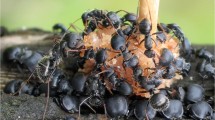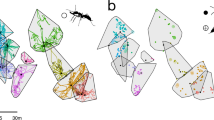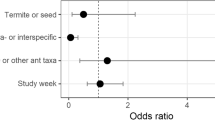Abstract
The discovery-exploitation tradeoff posits that ant colonies decide between investing in scouts (individual foraging and discovery) or recruits (collective foraging and exploitation) in order to optimize gains. Although this tradeoff has been thoroughly examined through theoretical modelling, research linking model findings to empirical comparative data in ant communities is lacking. We explore the discovery-exploitation tradeoff within an old field ant community in the novel context of a multispecies mutualism with the treehopper Publilia concava. Specifically, we examine the relationship between foraging strategy and ant attentiveness to their treehopper partner, changes in foraging strategy in response to dynamic resources, and how different attendance phenotypes affect partner fecundity. We categorized ants via behavioral assays into “attentive” and “non-attentive” behavioral groups. Foraging strategy differed between ant groups during treehopper oviposition, with “attentive” and “non-attentive” ants favoring collective and individual foraging strategies, respectively. As treehopper nymphs emerged, “non-attentive” Formica subsericea shifted to collective foraging, with a corresponding rapid increase in ant recruitment, while ant recruitment in “attentive” ants remained constant. Treehopper fecundity, however, did not differ when tended by either “attentive” or “non-attentive” ants. We suggest that differences in foraging strategy could be due to residual honeydew left by maternal treehoppers on egg masses, which “attentive” ants exploit. Early recruitment in “attentive” and behaviorally subordinate ants might lead to priority effects, allowing them to persist on host plants and deter invasion from competing ants, which could ultimately lead to species coexistence.




Similar content being viewed by others
Data Availability
Data is available upon request from GJLT.
Code availability
All statistical code was carried out in R 3.6.1. Code is available upon request from GJLT.
References
Afkhami ME, Rudgers JA, Stachowicz JJ (2014) Multiple mutualist effects: conflict and synergy in multispecies mutualisms. Ecology 95:833–844
Axén AH (2000) Variation in behavior of lycaenid larvae when attended by different ant species. Evol Ecol 14:611–625
Bates D, Mächler M, Bolker B, Walker S (2015) Fitting linear mixed-effects models using lme4. J Stat Softw 67:1–48
Beekman M, Sumpter DJT, Ratnieks FLW (2001) Phase transition between disordered and ordered foraging in pharaoh’s ants. Proc Natl Acad Sci U S A 98:9703–9706
Billick I, Weidmann M, Reithel J (2001) The relationship between ant-tending and maternal care in the treehopper Publilia modesta. Behav Ecol Sociobiol 51:41–46
Bleiker KP, Six DL (2009) Competition and coexistence in a multi-partner mutualism: interactions between two fungal symbionts of the mountain pine beetle in beetle-attacked trees. Microb Ecol 57:191–202
Bristow CM (1983) Treehoppers transfer parental care to ants: a new benefit of mutualism. Science 220:532–533
Bronstein JL (1994) Our current understanding of mutualism. Q Rev Biol 69:31–51
Buckley RC (1987) Interactions involving plants, Homoptera, and ants. Annu Rev Ecol Syst 18:111–135
Buczkowski G, Bennett G (2008) Seasonal polydomy in a polygynous supercolony of the odorous house ant, Tapinoma sessile. Ecol Entomol 33:780–788
Buczkowski G, Bennett GW (2006) Dispersed central-place foraging in the polydomous odorous house ant, Tapinoma sessile as revealed by a protein marker. Insectes Soc 53:282–290
Cammaerts MC, Cammaerts R (1980) Food recruitment strategies of the ants Myrmica sabuleti and Myrmica ruginodis. Behav Processes 5:251–270
Cerdá X, Angulo E, Boulay R, Lenoir A (2009) Individual and collective foraging decisions: A field study of worker recruitment in the gypsy ant Aphaenogaster senilis. Behav Ecol Sociobiol 63:551–562
Chesson P (2000) Mechanisms of maintenance of species diversity. Annu Rev Ecol Syst 31:343–366
Clark RE, Singer MS (2018) Differences in aggressive behaviors between two ant species determine the ecological consequences of a facultative food-for-protection mutualism. J Insect Behav 31:510–522
Davidson DW (1998) Resource discovery versus resource domination in ants: a functional mechanism for breaking the trade-off. Ecol Entomol 23:484–490
Del-Claro K, Oliveira PS (2000) Conditional outcomes in a neotropical treehopper-ant association: temporal and species-specific variation in ant protection and homopteran fecundity. Oecologia 124:156–165
Del-Claro K, Oliveira PS (1996) Honeydew flicking by treehoppers provides cues to potential tending ants. Anim Behav 51:1071–1075
Deneubourg JL, Aron S, Goss S et al (1986) Random behaviour, amplification processes and number of participants: how they contribute to the foraging properties of ants. Phys D Nonlinear Phenom 22:176–186
Devegili AM, Lescano MN, Gianoli E, Farji-Brener AG (2020) Defence variation within a guild of aphid-tending ants explains aphid population growth. Ecol Entomol 45:1180–1189
Djiéto-Lordon C, Dejean A, Gibernau M et al (2004) Symbiotic mutualism with a community of opportunistic ants: protection, competition, and ant occupancy of the myrmecophyte Barteria nigritana (Passifloraceae). Acta Oecologica 26:109–116
Fagundes R, Ribeiro SP, Del-Claro K (2013) Tending-ants increase survivorship and reproductive success of Calloconophora pugionata Drietch (Hemiptera, Membracidae), a trophobiont herbivore of Myrcia obovata O. Berg (Myrtales, Myrtaceae). Sociobiology 60:11–19
Feldhaar H, Fiala B, Hashim RB, Maschwitz U (2003) Patterns of the Crematogaster-Macaranga association: the ant partner makes the difference. Insectes Soc 50:9–19
Fellers JH (1987) Interference and exploitation in a guild of woodland ants. Ecology 68:1466–1478
Fonseca CR, Benson WW (2003) Ontogenetic succession in Amazonian ant trees. Oikos 102:407–412
Fox J, Weisberg S (2019) An R companion to applied regression, 3rd edn. Sage, Thousand Oaks, CA
Frederickson ME (2005) Ant species confer different partner benefits on two neotropical myrmecophytes. Oecologia 143:387–395
Gordon DM (1983) The relation of recruitment rate to activity rhythms in the harvester ant, Pogonomyrmex barbatus (F. Smith) (Hymenoptera: Formicidae). J Kansas Entomol Soc 56(3):277–285
Hinton HE (1977) Subsocial behaviour and biology of some Mexican membracid bugs. Ecol Entomol 2:61–79
Hölldobler B, Wilson EO (1990) The Ants. Harvard University Press, Cambridge
Itioka T, Inoue T (1996) Density-dependent ant attendance and its effects on the parasitism of a honeydew-producing scale insect, Ceroplastes rubens. Oecologia 106:448–454
Jaffe K, Deneubourg JL (1992) On foraging, recruitment systems and optimum number of scouts in eusocial colonies. Insectes Soc 39:201–213
Johnson CA, Bronstein JL (2019) Coexistence and competitive exclusion in mutualism. Ecology 100:1–8
Jones EI, Bronstein JL, Ferrière R (2012) The fundamental role of competition in the ecology and evolution of mutualisms. Ann N Y Acad Sci 1256:66–88
Knowlton N, Rohwer F (2003) Multispecies microbial mutualisms on coral reefs: the host as a habitat. Am Nat 162:S51–S62
Lefcheck JS (2016) Piecewise SEM: piecewise structural equation modelling in R for ecology, evolution, and systematics. Methods Ecol Evol 7:573–579
Mailleux AC, Deneubourg JL, Detrain C (2000) How do ants assess food volume? Anim Behav 59:1061–1069
Messina FJ (1981) Plant protection as a consequence of an ant-membracid mutualism: interactions on goldenrod (Solidago Sp.). Ecology 62:1433–1440
Morales MA (2011) Model selection analysis of temporal variation in benefit for an ant-tended treehopper. Ecology 92:709–719
Morales MA (2000a) Survivorship of an ant-tended membracid as a function of ant recruitment. Oikos 90:469–476
Morales MA (2000b) Mechanisms and density dependence of benefit in an ant-membracid mutualism. Ecology 81:482–489
Morales MA (2002) Ant-dependent oviposition in the membracid Publilia concava. Ecol Entomol 27:247–250
Morales MA, Beal ALH (2006) Effects of host plant quality and ant tending for treehopper Publilia concava. Ann Entomol Soc Am 99:545–552
Morales MA, Zink AG (2017) Mechanisms of aggregation in an ant-tended treehopper: Attraction to mutualists is balanced by conspecific competition. PLoS ONE 12:1–10
Nagelkerke NJDD (1991) A note on a general definition of the coefficient of determination. Biometrika 78:691–692
Nakagawa S, Schielzeth H (2013) A general and simple method for obtaining R2 from generalized linear mixed-effects models. Methods Ecol Evol 4:133–142
Ogle DH, Wheeler P, Dinno A (2019) FSA: Fisheries stock analysis. R package version 0.8.25
Palmer TM, Doak DF, Stanton ML et al (2010) Synergy of multiple partners, including freeloaders, increases host fitness in a multispecies mutualism. Proc Natl Acad Sci U S A 107:17234–17239
Palmer TM, Young TP, Stanton ML (2002) Burning bridges: priority effects and the persistence of a competitively subordinate acacia-ant in Laikipia, Kenya. Oecologia 133:372–379
Portha S (2002) Self-organized asymmetries in ant foraging: a functional response to food type and colony needs. Behav Ecol 13:776–781
R Core Team (2020) R: A language and environment for statistical computing. R Foundation for Statistical Computing, Vienna, Austria. URL https://www.R-project.org/
Root RB (1965) The guild concept and community analysis. Bull Ecol Soc Am 46:177
Savolainen R, Vepsäläinen K, Vepsalainen K (1989) Niche differentiation of ant species within territories of the wood ant Formica polyctena. Oikos 56:3
Schoener TW (1983) Field experiments on interspecific competition. Am Nat 122:240–285
Shibao H, Morimoto M, Okumura Y, Shimada M (2009) Fitness costs and benefits of ant attendance and soldier production for the social aphid Pseudoregma bambucicola (Homoptera: Aphididae: Hormaphidinae). Sociobiology 54:673–698
Smallwood J (1982) Nest relocations in ants. Insectes Soc 29:138–147
Stadler B, Dixon AFG (1998) Costs of ant attendance for aphids. J Anim Ecol 67:454–459
Stadler B, Dixon AFG (2005) Ecology and evolution of aphid-ant interactions. Annu Rev Ecol Evol Syst 36:345–372
Stanton ML (2003) Interacting guilds: moving beyond the pairwise perspective on mutualisms. Am Nat 162(S4):S10–S23
Stanton ML, Palmer TM, Young TP (2002) Competition-colonization trade-offs in a guild of African acacia-ants. Ecol Monogr 72:347–363
Tallamy DW, Wood TK (1986) Convergence patterns in subsocial insects. Annu Rev Entomol 31:369–390
van Oudenhove L, Cerdá X, Bernstein C (2018) Dominance-discovery and discovery-exploitation trade-offs promote diversity in ant communities. PLoS ONE 13:1–24
Wang B, Lu M, Cook JM et al (2018) Chemical camouflage: a key process in shaping an ant-treehopper and fig-fig wasp mutualistic network. Sci Rep 8:1–10
Way MJ (1963) Mutualism between ants and honeydew-producing Homoptera. Annu Rev Entomol 8:307–344
Yao I, Shibao H, Akimoto SI (2000) Costs and benefits of ant attendance to the drepanosiphid aphid Tuberculatus quercicola. Oikos 89:3–10
Yoo HJS, Holway DA (2011) Context-dependence in an ant-aphid mutualism: direct effects of tending intensity on aphid performance. Ecol Entomol 36:450–458
Zink AG (2003) Quantifying the costs and benefits of parental care in female treehoppers. Behav Ecol 14:687–693
Acknowledgements
We thank the Darling Marine Center of the University of Maine for use of the study site and H. M. Leslie, T.E. Miller, L. Healy, and other staff members for facilitating fieldwork on the premises. J. F. Witman and an anonymous reviewer provided helpful feedback on the statistical analysis of our data and earlier drafts of the manuscript. GJLT was supported by a Brown University Karen T. Romer Undergraduate Teaching and Research Award (UTRA).
Funding
GJLT was supported by a Brown University Karen T. Romer Undergraduate Teaching and Research Award (UTRA).
Author information
Authors and Affiliations
Contributions
GJLT conceived and designed this study under the guidance of DHM. GJLT conducted fieldwork, performed statistical analyses, and wrote the manuscript. DHM provided editorial advice.
Corresponding author
Ethics declarations
Conflicts of Interest
The authors declare that they have no conflict of interest.
Additional information
Publisher’s Note
Springer Nature remains neutral with regard to jurisdictional claims in published maps and institutional affiliations.
Rights and permissions
About this article
Cite this article
Tiong, G.J.L., Morse, D.H. Discovery-exploitation tradeoffs in a multispecies ant-treehopper mutualism: foraging strategy differences and temporal changes across ant attendance behaviors. J Insect Behav 34, 173–185 (2021). https://doi.org/10.1007/s10905-021-09782-0
Received:
Revised:
Accepted:
Published:
Issue Date:
DOI: https://doi.org/10.1007/s10905-021-09782-0




